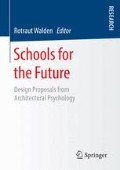Abstract
The history of the American schoolhouse reflects the history of education that in turn mirrors a plethora of contextual societal forces including social, economic, and political ones. The architectural form and layout of the school building has historically been influenced by the evolution of educational philosophy and goals, curricular objectives, instructional methods, and cultural values of schools. For example, the architecture of the small one-room country school building was an appropriate design response that served the basic educational and social needs of small rural communities for well over 200 years in the United States. As the social problems associated with the rise of the Industrial Revolution increased in the mid and late 19th century, the need for educating larger groups of immigrants in urban centers became central. Large multistoried classroom buildings provided the necessary educational and architectural response at that time to the common school movement.
Access this chapter
Tax calculation will be finalised at checkout
Purchases are for personal use only
Preview
Unable to display preview. Download preview PDF.
References
Barth, R. (1972). Open Education and the American School. New York: Agathon.
Barker, R.G., & Gump, P.V. (1964). Big school, small school. Palo Alto, CA: Stanford University Press.
Brubaker, C.W. (1998). Planning and designing schools. New York: McGraw-Hill.
Carnegie Foundation. (1988). An imperiled generation: Saving urban schools. Princeton, NJ: Carnegie Foundation for the Advancement of Teaching.
Costa, A.L., & Liebmann, R.M. (Eds.). (1997). The process-centered school: Sustaining a renaissance community. Thousand Oaks, CA: Corwin.
Cotton, Kathleen (1996). Affective and Social Benefits of Small-Scale Schooling. (ERIC Document Reproduction Service EDO-RC-96-5).
DeYoung, A.J. (1989). Economics and American education: A historical and critical overview of the impact of economic theories on schooling in the United States. New York: Longman.
Ehrenkrantz, E. (1999, September). Planning for flexibility, not obsolescence. Keynote address presented at the UEF-21 Conference at the New Jersey Institute of Technology, Newark, NJ, September 17, 1999. Retrieved from http://www.designshare.com/Research/EEK/Ehrenkrantz1.htm
Fowler, W., & Walberg, H.J. (1991). School size, characteristics and outcomes. Educational Evaluation and Policy Analysis, 13, 189–202.
George, P.S., & Alexander, W.M. (1993). The exemplary middle school. Fort Worth, TX: Holt, Rinehart and Winston.
Graves, B. (1993). School ways: The planning and design of America’s schools. New York: McGraw-Hill.
Gulliford, A. (1984). America’s country schools. Washington, DC: Preservation Press.
Gulliford, A. (1996). America’s country schools. (3rd ed.). Washington, DC: Preservation Press. Herbst, J. (1996). The once and future school: Three hundred and fifty years of American secondary education. New York: Routledge.
Johnson, C. (1963). Old-time schools and schoolbooks. (First published in 1904 by Macmillan). New York: Dover.
Lackney, J.A. (1994). Educational facilities: The impact and role of the physical environment of the school on teaching, learning and educational outcomes. Milwaukee, WI: Center for Architecture and Urban Planning Research, University of Wisconsin-Milwaukee.
Marks, J. (2000). The Educational Facilities Laboratories (EFL): A history. Washington DC: National Clearinghouse for Educational Facilities.
McAndrews, T., & Anderson, W. (2002). Schools within schools. ERIC Digest 154. College of Education, University of Oregon: Clearinghouse on Educational Management.
McClintock, J., & McClintock, R. (1970). Henry Barnard’s school architecture. New York: Teachers College Press.
Meek, A. (Ed.). (1995). Designing places for learning. Alexandria, VA: Association for Supervision and Curriculum Development.
National Council on Schoolhouse Construction (NCSC). (1953). Guide for planning school plants. National Council on Schoolhouse Construction (now Council of Educational Facility Planners, International). Nashville, TN: Peabody College.
Rieselbach, A. (1992). “Building and Learning”. In The Architectural League (Eds.), New schools for New York: Plans and precedents for small schools. New York: Princeton Architectural Press.
Rothenberg, J. (1989). The open classroom reconsidered. Elementary School Journal, 90, 69–86.
Saint, A. (1987). Towards a social architecture: The role of school building in post-War England. New Haven, CT: Yale University Press.
Tanner, L.N. (1997). Dewey’s Laboratory School: Lessons for today. New York: Teachers College Press.
Trotter, A. (2000, October 25). States virtually carried away over online high schools. Education Week, 20(8), 22.
Wolff, S.J. (2001, September). Sustaining systems of relationships: The essence of the physical learning environment that supports and enhances collaborative, project-based learning at the community college level. Unpublished dissertation, School of Education, Oregon State University.
Author information
Authors and Affiliations
Editor information
Editors and Affiliations
Rights and permissions
Copyright information
© 2015 Springer Fachmedien Wiesbaden
About this chapter
Cite this chapter
Lackney, J. (2015). History of the Schoolhouse in the USA. In: Walden, R. (eds) Schools for the Future. Springer, Wiesbaden. https://doi.org/10.1007/978-3-658-09405-8_2
Download citation
DOI: https://doi.org/10.1007/978-3-658-09405-8_2
Published:
Publisher Name: Springer, Wiesbaden
Print ISBN: 978-3-658-09404-1
Online ISBN: 978-3-658-09405-8
eBook Packages: Behavioral ScienceBehavioral Science and Psychology (R0)

